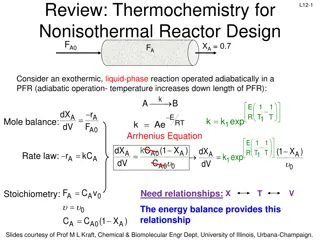
Understanding Distributed File Systems in Operating Environments
Discover the role of file systems in managing data, the concept of distributed file systems operating across multiple hosts, and the goals of a general-purpose distributed file system in simplifying user experience.
Download Presentation

Please find below an Image/Link to download the presentation.
The content on the website is provided AS IS for your information and personal use only. It may not be sold, licensed, or shared on other websites without obtaining consent from the author. If you encounter any issues during the download, it is possible that the publisher has removed the file from their server.
You are allowed to download the files provided on this website for personal or commercial use, subject to the condition that they are used lawfully. All files are the property of their respective owners.
The content on the website is provided AS IS for your information and personal use only. It may not be sold, licensed, or shared on other websites without obtaining consent from the author.
E N D
Presentation Transcript
14-736: DISTRIBUTED SYSTEMS LECTURE 12 * SPRING 2018 * KESDEN
WHAT ARE DISTRIBUTED FILE SYSTEMS? Maybe we d better start with what are file systems? Maybe we d better start with what are files? A file is a unit of data organized by the user. The data within a file isn't necessarily meaningful to the operating system. Instead, a file is created by the user and meaningful to the user. It is the job of the file system to maintain this unit, without understanding or caring why. Contrast this with a record in a database, which is described by a schema and upon which the database enforces constraints
WHAT ARE DISTRIBUTED FILE SYSTEMS? Okay. We got files. So, what are file systems? A file system is a service responsible for managing files. File systems typically implement persistent storage, although volatile file systems are also possible (/proc is such an example).
WHAT DOES IT MEAN TO MANAGE FILES? Name files in meaningful ways. The file system should allow a user to locate a file using a human-friendly name. In many cases, this is done using a hierarchical naming scheme like those we know and love in Windows, UNIX, Linux, &c. Access files. Create, destroy, read, write, append, truncate, keep track of position within, &c Physical allocation. Decide where to store things. Reduce fragmentation. Keep related things close together, &c. Security and protection. Ensure privacy, prevent accidental (or malicious) damage, &c. Resource administration. Enforce quotas, implement priorities, &c.
WHAT ARE DISTRIBUTED FILE SYSTEMS? Got files. Got file systems. Well, it is a type of file system, which means that it is a file system. The distinction isn't what it is or what it does but the environment in which it does it. A traditional file system typically has all of the users and all of the storage resident on the same machine. A distributed file system typically operates in an environment where the data may be spread out across many, many hosts on a network -- and the users of the system may be equally distributed.
GOAL OF A GENERAL PURPOSE DISTRIBUTED FILE SYSTEM (DFS) A general purpose distributed file system should appear to the user as if a local file system Users shouldn t have to worry about details such as Where files are located How to identify the locations How many replicas there are If the replicas are up to date What happens if part of the system fails, e.g. partitioning, host failure, etc.
WHY MIGHT WE WANT A GENERAL PURPOSE DISTRIBUTED FILE SYSTEM? More storage More throughput More robustness from host and storage failure More robust from environmental hazards Faster access, e.g. closer to users Etc.
RECALL, FOR EXAMPLE, UNIX- STYLE FILE SYSTEMS
UNIX-LIKE FILE SYSTEMS, CONTINUED Virtual File System (VFS) File system, inode are base classes Known as Virtual file system (VFS) and vnode Specific implementation is derived type Implementation may be legit OO, e.g. C++ Or, implementation may, for example, ugly C with unions, etc. Implementation abstracted from interface Distributed File Systems can be just an alternative implementation for storage
GENERAL PURPOSE DISTRIBUTED FILE SYSTEM Maintain same naming system Mount in UNIX Map in Windows, etc Just change storage layer to use network and manage errors
NETWORK FILE SYSTEM (NFS) EARLY VERSIONS Not a DFS Simply central storage accessed via network Client made requests on per-block basis Stateless server No client caching Turned out to be too painful Clients cached anyway Just accepted staleness for a while since no way to validate Evolved over time into DFS with support for caching
ANDREW FILE SYSTEM (AFS) OUR FRIEND Stateful server Callback mechanism Invalidates client caches upon change, but in use copies unaffected Whole-file semantics Modified to move blocks in version 2.x (when it left CMU and went to IBM)
CODA Extension of AFS Project Added replication Added weakly connected mode: One server replicates on behalf of client Added disconnected mode: Uploaded and resolved by client later Hoard demon: Pull whole files needed for later Spy: Figure out which files to hoard. Client-side resolution Insert CVV discussion again here

